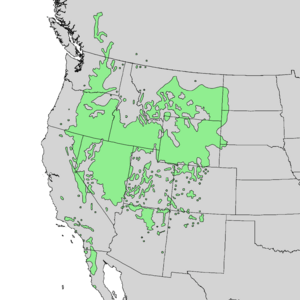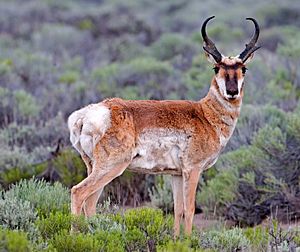Big sagebrush facts for kids
Quick facts for kids Big sagebrush |
|
|---|---|
 |
|
| Sagebrush growing in San Juan County, New Mexico | |
| Scientific classification | |
| Genus: |
Artemisia
|
| Species: |
tridentata
|
 |
|
| Natural range of Artemisia tridentata | |
| Synonyms | |
|
Synonymy
Seriphidium tridentatum (Nutt.) W.A.Weber
Artemisia angusta Rydb. Artemisia parishii A.Gray Artemisia vaseyana Rydb. Seriphidium vaseyanum (Rydb.) W.A.Weber |
|
Artemisia tridentata, often called big sagebrush, is a fragrant shrub. It belongs to the Asteraceae family, which includes daisies. This plant grows in dry and semi-dry areas. You can find it in cold deserts, grasslands, and mountains. These areas are mostly in the western part of North America.
The name "sagebrush" is also used for other plants in the Artemisia group. One example is California sagebrush (Artemisia californica). Big sagebrush is the main plant in large parts of the Great Basin. Its range stretches from British Columbia in Canada down to Baja California. It also goes east into the western Great Plains in states like New Mexico and Colorado.
Big sagebrush provides food and shelter for many animals. These include sage grouse, pronghorn, pygmy rabbit, and mule deer. It is very important for these animals, especially during winter. People sometimes use its wood for firewood. The plant's natural oils make it burn easily. Big sagebrush is also the official state flower of Nevada.
What is Big Sagebrush?
Big sagebrush is a rough, bushy shrub. It usually grows between 0.5 and 3 meters (about 1.5 to 10 feet) tall. It has pale grey branches, yellow flowers, and silvery-grey leaves. The plant has a deep main root that can go 1 to 4 meters (3 to 13 feet) down. It also has roots that spread out near the surface. This helps it get water from both rain and deeper underground.
If you see big sagebrush over a meter tall, it often means the soil is good for farming. This plant likes deep, basic soils. Big sagebrush can live for a long time, often over 100 years. This happens if it survives its early seedling stage.
The plant has a strong, sharp smell, especially when it's wet. This smell comes from natural oils like camphor. The taste is bitter. This strong smell and taste help keep many plant-eating animals away. Big sagebrush is an evergreen shrub. This means it keeps some of its leaves all year. However, it does lose many leaves in late summer.
Its leaves are shaped like a wedge, about 1 to 3 cm long. They are 0.3 to 1 cm wide. The wider tips of the leaves usually have three small lobes. This is why its scientific name is tridentata, meaning "three-toothed". The leaves are covered with fine, silvery hairs.
Big sagebrush flowers in late summer or early fall. Its small yellow flowers grow in long, loose groups. The fruits are like tiny seeds. They have a few hairs on their surface. The Cahuilla people used to collect many sagebrush seeds. They would grind them to make flour.
Big sagebrush can also grow new plants from sprouts. These sprouts grow from underground stems called rhizomes. Sprouts are connected to the parent plant. New seedlings, however, start all on their own. Seedlings need more moisture to grow than sprouts do.
Where Big Sagebrush Lives
Big sagebrush grows in dry and semi-dry places. It is found across the western part of North America. Sagebrush is not a true desert plant. It prefers grasslands that get about 18 to 40 cm (7 to 16 inches) of rain each year. Big sagebrush and other Artemisia plants are the main plants in the Great Basin. They cover a huge area of about 422,000 square miles (1.1 million square kilometers). This area spans 11 western U.S. states and parts of Canada.

Sagebrush provides food and shelter for many animals. These include sage grouse, pronghorn, pygmy rabbit, and mule deer. It also helps many types of grasses and other small plants grow. Sagebrush offers shade and protection from the wind. Its long taproot brings water up from deep in the soil. This water then becomes available for other plants with shallow roots.

The natural chemicals in big sagebrush help protect it from animals that eat plants. These oils can be harmful to the helpful bacteria in the stomachs of some animals, like deer and cattle. Pronghorn are one of the few large animals that eat a lot of sagebrush. When animals graze on sagebrush, the plants release special chemicals into the air. These chemicals warn nearby sagebrush plants. This makes them produce more of their protective compounds. This plant-to-plant warning can happen over distances of up to 60 cm (2 feet).

Big sagebrush habitats face several big problems. These include human towns, turning land into farms, and animals grazing too much. Invasive plants, wildfires, and climate change also cause harm. The cattle industry sometimes burns large areas of sagebrush. This is done to create more land for grazing animals. Many animals have adapted to live in sagebrush areas. Burning these shrubs destroys their homes. This can be very bad for the whole ecosystem.
Also, when native grasses are destroyed by grazing or fire, invasive plants can take over. The invasive plant that has caused the most damage is cheatgrass. It was accidentally brought here in the 1890s. Cheatgrass has changed the natural shrub ecosystem a lot. It replaces native plants. It also creates fires that happen too often for sagebrush to grow back. Sagebrush cannot survive fires. It needs seeds blown in by the wind from other areas to grow again. Some tree species are also moving into big sagebrush areas. For example, in the Warner Mountains in California, white fir trees are growing better than big sagebrush.
Traditional Uses
Native Americans in the western United States have used big sagebrush as a herbal medicine. It is often used for smudging, which is a spiritual practice. It has also been used to prevent infections in wounds. People used it to stop internal bleeding and to treat headaches and colds.
The active parts of the plant that help with medicine include camphor and other natural chemicals. The Navajo used the steam from sagebrush to treat headaches. The Okanagan and Colville people used sagebrush to smoke animal hides.
The Zuni people used a liquid made from the leaves on their skin for body aches. They also drank it as a cold medicine. They even put it in their shoes to help with athlete's foot and as a foot deodorant.
Safety Notes
The oils in sagebrush can be harmful to the liver and digestive system if swallowed by humans. So, it's important to be careful if using it internally. If someone accidentally eats the plant, any harmful effects usually go away within 24 to 48 hours.
See also
 In Spanish: Artemisia tridentata para niños
In Spanish: Artemisia tridentata para niños


